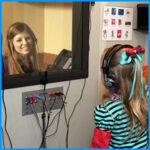Middle Ear Conditions
Here we take a look at common middle ear conditions we regularly treat children for.
We discuss:
- Ear Infections
- Ear Drum Perforation
- Conductive Hearing Loss
Ear Infections
It is very common for children to develop middle ear infections during the first few years of life. A middle ear infection (otitis media) is inflammation of the space behind the eardrum, with associated fluid. In an otitis media, the fluid is pus filled, and the eardrum bulges due to the fluid, producing ear pain.
Middle ear infections typically develop from the presence of an upper respiratory tract. The upper respiratory infection produces swelling to the nasal passages, resulting in blockage of the Eustachian tube (the tube that connects the ear into the nose). This blockage causes pressure changes, leading to fluid production in the middle ear space. The viral infection produces changes to the nasal passage so that bacteria that reside in the back of the nose travel into the middle ear space, infecting the fluid.
Ear Drum Perforation
A middle ear infection might also cause a child’s eardrum to rupture. Children who have an acute otitis media may have drainage that exits the ear canal. The drainage may be clear or pus colored. The perforations typically are very small, almost pin like, and usually close over quickly. Children who develop a perforation have resolution of the pain associated with the infection.
Conductive Hearing Loss
Children who develop an acute otitis media or have middle ear fluid may exhibit hearing loss. The sound conduction is dampened by the fluid, resulting in the hearing loss. The majority of time the hearing loss is temporary and improves as the fluid disappears. Children with a perforation that persists may also develop hearing loss.


